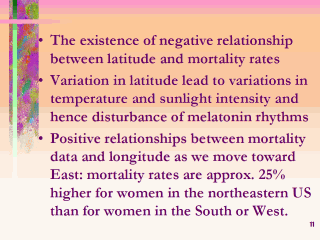 |
To further examine
the idea that temperature can influence breast cancer rates, we investigate
the relationship (if any) between mortality rates and geographic
coordinates: latitude and longitude. The principal controls of temperature
variations are latitude and elevation (altitude). The latitude for a given
point on the earth has an effect on temperature, the farther away from the
Equator (0° ) a point is the cooler average
temperature that point is likely to have, see Fig 3. We obtained worldwide
breast cancer mortality statistics from WHO Cancer Mortality Database, WHO/IARC
(http://www-depdb.iarc.fr/who).
We investigated the possible correlation between the geographic coordinates
of the countries and the age-specific rates (ASR) of breast mortality. The
latitude and longitude figures for the purpose of finding the approximate
geographic center of an entity and is based on the Gazetteer of Conventional
Names, Third edition, August 1988, US Board on Geographic Names. The result
is shown on Table VI. The result revealed that there is existing negative
relationship between latitude and mortality rates, i.e. by increasing
latitude the death rate increases. Variations in latitude lead to variations
in the temperature and sunlight intensity and hence for disturbance of
melatonin rhythms, see Table V. A previous report, investigators showed
evidence for a link between cosmic ray intensity and cancer due to
variations in the latitude 19. Referring to Table V, it seems
reasonable to assume, therefore, that low intensity light may have direct
effect on the inhibition/disturbance of melatonin rhythms, compared to high
intensity sunlight (approx. x100000 lux). Recently, it was
demonstrated that light-induced melatonin suppression in humans is sensitive
to short wavelength light (420 – 480 nm;
l max @
460 nm) 20,21,22,23. |
